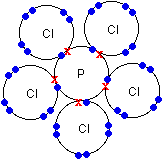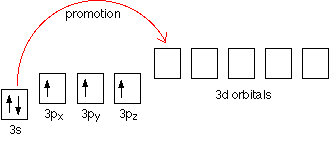The chlorine atoms obey the octet rule, but the phosphorus atom does not. In a molecule of phosphorus pentachloride, #PCl_5#, each chlorine atom ends up with an octet of electrons (four pairs), but the phosphorus atom ends up with ten electrons (five pairs).

To understand this, we need to look at the electron configuration of a phosphorus atom, which is #[Ne]3s^"2"3p^"3"#, in which each of the three p electrons are unpaired and available for bonding by sharing three electrons.

However, in #PCl_5#, the phosphorus atom shares five electrons, one each with the five chlorine atoms. The phosphorus atom can do this because it can promote one of the #3s# electrons into a #3d# orbital, which now makes five unpaired electrons available for bonding.


Experiments have shown that all five of the bonds with chlorine are identical. This indicates that the orbitals have hybridized, forming five #sp^3d# hybrid orbitals.






